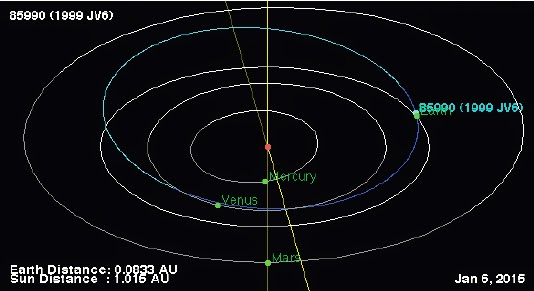Asteroid (162004) 1991 VE passed by the Earth at a distance of about 15 600 000 km (40.6 times the average distance between the Earth and the Moon, or 10.4% of the average distance between the Sun and the Earth), slightly after 3.30 am GMT on Saturday 17 January 2015. There was no danger of the asteroid hitting us, though were it to do so it would have presented a serious threat. (162004) 1991 VE has an estimated equivalent diameter of between 430 m and 1.4 km (i.e. it is estimated that a spherical object with the same volume would be between 430 m and 1.4 km in diameter), and an object of this size would be predicted to be capable of passing through the Earth's atmosphere relatively intact, impacting the ground with an energy equivalent to between 3000 and 50 000 megatons of TNT (between 176 500 and 3 000 000 times the energy of the Hiroshima bomb). Such an event would result in a crater between 7 and 16 km across, cause devastation on a global scale and would have the potential to affect the climate globally for centuries after the impact event.
Observations of (162004) 1991 VE made from the RAS Observatory in Mayhill, New Mexico, on 14 November 2007. The asteroid is the moving point, the elongate objects are stars, the shape of which reflects the movement of the telescope. Andrew Lowe's Minor Planet Home Page.
(162004) 1991 VE was discovered on 3 November 1991 by Eleanor Helin and Kenneth Lawrence at Palomar Observatory. The designation 1991 VE implies that it was the 6th asteroid (asteroid E) discovered in the first half of November (period 1991 V). The longer designation, 162004 indicates that the asteroid was the 162 004th asteroid ever discovered. Asteroids are not given this longer designation immediately, to avoid duplicate or false sightings; in this case (162004) 1991 VE was discovered independently in November 1997, and given the new designation 1997 WP23, before it was realized that this was the same object.
(162004) 1991 VE has a 307 day orbital period, with an elliptical orbit tilted at an angle of 7.2° to the plain of the Solar System which takes in to 0.30 AU from the Sun (30% of the distance at which the Earth orbits the Sun, considerably inside the orbit of Mercury) and out to 1.48 AU (48% further away from the Sun than the Earth, slightly less than the average distance at which the planet Mars orbits the Sun). This means that close encounters between the asteroid and Earth are fairly common, with the last thought to have happened in December 2013 and the next predicted in November 2017. Although it does cross the Earth's orbit and is briefly further from the Sun on each cycle, (162004) 1991 VE spends most of its time closer to the Sun than we are, and is therefore classified as an Aten Group Asteroid.
The calculated orbit of (162004) 1991 VE. JPL Small Body Database Browser.
This orbit also means that close encounters between (162004) 1991 VE and the other inner planets are quite common too. The asteroid last had a close encounter with Mercury in March 2010, and is predicted to have another in December 2026. It last had a close encounter with Venus in September 2007, with another predicted in December 2016. It last had a close encounter with Mars in April 1985, and another is predicted for April 2017. Asteroid orbits that have close encounters with multiple planets are considered to be quite unstable, as any perturbations can quickly become magnified, throwing the astroid onto a new orbital path. Thus while (162004) 1991 VE does not come within 0.05 AU of the Earth on its current orbit, and is not therefore classified as a Potentially Hazardous Asteroid, the future evolution of its orbit is a cause for concern.
See also...
Asteroid (410088) 2007 EJ passed by the Earth at a distance of about 26 500 000 km (68.9 times the average distance between the Earth and the Moon, or 17.7% of the average distance between the Sun ande...
 Fireball over Bucharest Witnesses reported seening a large fireball over Bucharest, Romania, at about 3.00 am local time on Thursday 7 January 2015. The event is reported to have lasted several seconds, and to have lit up the sky...
Fireball over Bucharest Witnesses reported seening a large fireball over Bucharest, Romania, at about 3.00 am local time on Thursday 7 January 2015. The event is reported to have lasted several seconds, and to have lit up the sky... Asteroid 1999 JV6 passes the Earth. Asteroid 1999 JV6 passed by the Earth at a distance of about 12 460 000 km (32.42 times the average distance between the Earth and the Moon, or 8.3% of the average distance between the Sun and the Earth)...
Asteroid 1999 JV6 passes the Earth. Asteroid 1999 JV6 passed by the Earth at a distance of about 12 460 000 km (32.42 times the average distance between the Earth and the Moon, or 8.3% of the average distance between the Sun and the Earth)...
Follow Sciency Thoughts on Facebook.



